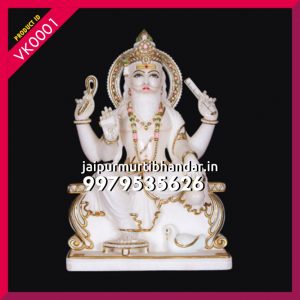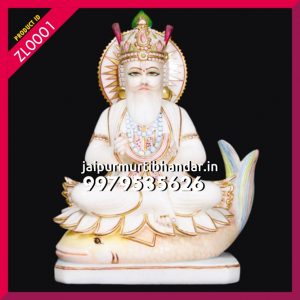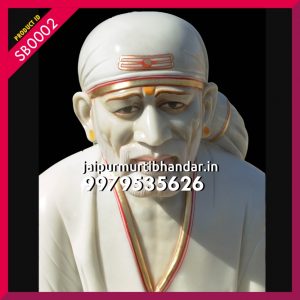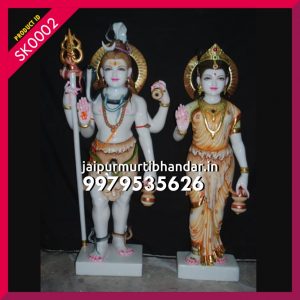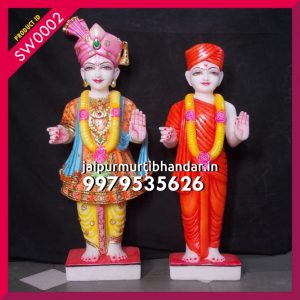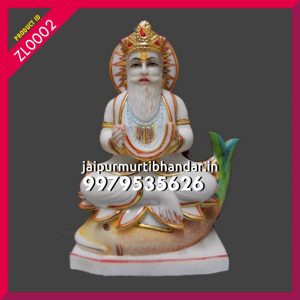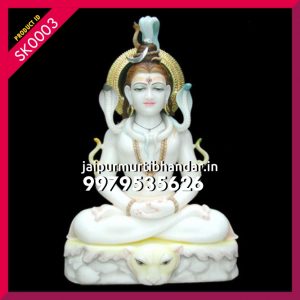-
Vishvakarma : VK-0001
Vishwakarma (Sanskrit for “all-accomplishing, maker of all, all-doer”) is personification of creation and the abstract form of the creator God according to the Rigveda. He is the presiding deity of all Vishwakarma (caste), engineers, artisans and architects.He is believed to be the “Principal Architect of the Universe “, and the root concept of the later Upanishadic figures of Brahman and Purusha.
He is mentioned as the son of K??yapa and Aditi and is said to have made the three worlds with pieces of the Sun god, Surya.
-
Zhulelal : ZL-0001
For Sindhi Hindus, Jhulelal is a name that refers to the Ishta Dev (most-revered deity) of Sindhi Hindus, who regard him to be an incarnation of the Hindu deity Varuna.The chant Jhule Lal Jhule Lal is considered the “clarion call” of Sindhi Hindus.
Jhulelal is traditionally believed to have performed several miracles, typically centred around the Indus River – which Hindus consider to be his abode.Sindhi Hindus worship Jhulelal at the Shrine at Odero Lal in Pakistan’s Sindh province, which is jointly used by Hindus, and Sindhi Muslims who revere the shrine as the tomb of Sheikh Tahir.
-
Dutt -DT0002
Shri Guru Dattatreya or Shri Datta Guru is Hindu deity (Ishta Devata) encompassing the trinity of Brahma, Vishnu and Shiva, collectively known as Trimurti. The name Dattatreya can be divided into two words – “Datta” (meaning given) and “Atreya” means, in Sanskrit, “son of Athri”. Athri is one of the 7 seers / principles of creation. Athri also means in Sanskrit “not three”. The one who came down from that which is not three is called Athreya. Dattatreya is also a combination of ?Datta? and ?treya? – Treya being the trinity ? Bramha (creator), Vishnu (preserver) and Shiva (destroyer).
In the Nath tradition Dattatreya is recognized as an Avatar or incarnation of the Lord Vishnu and as the Adi-Guru (first teacher) of the Adinath Sampradaya of the Naths. Dattatreya is primal manifestation in the Guru tradition (Supreme Guru principal). Dattatreya is considered to be the presiding deity (Ishta Devata) for the path of yoga ? therefore called as “Lord of Yoga”.
Shri Dattatreya is also known by another equally popular name of ?Avadhut?. Avadhut is one who washes away the temperamental defects i.e. the three qualities or Trigunas ? Sattva (Purity and Knowledge) Raja (Activity and Passion), Tama (Ignorance and Inertia). He destroys Trigunas. He bestows the spiritual experience of the unmanifest principle. Importance of Lord Datta from the seekers point of view is – There are many deities (Ishta Devatas or Ishvara) in Hindu religion, but there is only who is worshipped in the form of a Guru ? and he is Lord Datta. Hence the extolling (Jai-ghosh) of ?Avadhut Chintana Jai Gurudev Datta?. Shri Datta Guru is the ideal of the Guru principle and a proponent of Yoga.
-
Sai Baba : SB-0002
Sai Baba was a born to a Brahmin couple of Patri which was in the Nizam state of British India. Where his parents handed over him to the fakir. These were the words revealed by baba in his last days. But Date of birth is still unknown to the world. There are lots of communities who claims that Baba belong to their respective communities but none of them proven.
-
Shankar : SK-0002
In the Hindu mythology, Lord Shiva is the Destroyer and the most important one in the Holy Trinity, the other two being Brahma the Creator and Vishnu the Protector. Lord Shiva has always fascinated his followers by his unique appearance: he has not two but three eyes, has ash smeared all over his body, has snakes coiled up around his head and arms, wears tiger and elephant skin, leads a wild life in the cremation grounds far removed from social pretenses, and is known for his proverbial anger..
-
Shrinath Ji : SH-0002
Shrinathji?s idol was brought to Rajasthan from Govardhana near Vrindavan to protect it from the hands of the Mughal emperor Aurangzeb who in 1665 was bent upon vandalizing the area of Vrindavan by widespread destruction of Hindu temples. When the Mughal army came to Govardhana, the devotees of the Lord showed them the titles and gifts given to the temple by the previous Mughal rulers. The army commander then ordered the deity to be taken away from Govardhana. For almost six months the statue stayed in Agra after which the custodians of the idol of Shrinathji left that place with the idol in search of a new heaven.
-
Swaminarayan : SW-0002
The Swaminarayan Sampraday began as the Uddhav Sampraday and was led by Ramanand Swami. In 1799, Swaminarayan, born as Ghanshyam Pande, was initiated into the Uddhav Sampraday as an ascetic (Sadhu) by his guru, Ramanand Swami, and given the name “Sahajanand Swami”. At the age of 21, Neelkanth Varni was given the leadership of the sect known as Uddhav Sampraday with the blessings of Ramanand Swami, who handed him control of the religious diocese shortly before his death. Fourteen days after Ramanand Swami died, Neelkanth Varni, now known as Sahajanand Swami, held a large gathering of followers at the town of Faneni. It was during this meeting that Swaminarayan introduced what he termed “the father of all Mantras” and described it as “maha” (or great).[8] Then he was known as Swaminarayan, and the name “Swaminarayan Sampraday” came into existence.
At the age of 49, Swaminarayan took Samadhi at Gadhada in 1830 and died, after he promised to remain within the Swaminarayan Sampraday in the images he installed (and by the Acharyas succeeding him), the Acharyas and saints installed by him (and those in direct succession), the saints he initiated (and those initiated by succeeding Acharyas) and the scriptures, such as Shikshapatri, Vachanamrut, Satsangi Jeevan, Nishkhulanand Kavya and Yamdand (and those authorised by succeeding Acharyas).
-
Vishvakarma : VK-0002
Vishwakarma (Sanskrit for “all-accomplishing, maker of all, all-doer”) is personification of creation and the abstract form of the creator God according to the Rigveda. He is the presiding deity of all Vishwakarma (caste), engineers, artisans and architects.He is believed to be the “Principal Architect of the Universe “, and the root concept of the later Upanishadic figures of Brahman and Purusha.
He is mentioned as the son of K??yapa and Aditi and is said to have made the three worlds with pieces of the Sun god, Surya.
-
Zhulelal : ZL-0002
For Sindhi Hindus, Jhulelal is a name that refers to the Ishta Dev (most-revered deity) of Sindhi Hindus, who regard him to be an incarnation of the Hindu deity Varuna.The chant Jhule Lal Jhule Lal is considered the “clarion call” of Sindhi Hindus.
Jhulelal is traditionally believed to have performed several miracles, typically centred around the Indus River – which Hindus consider to be his abode.Sindhi Hindus worship Jhulelal at the Shrine at Odero Lal in Pakistan’s Sindh province, which is jointly used by Hindus, and Sindhi Muslims who revere the shrine as the tomb of Sheikh Tahir.
-
Dutt -DT0003
Shri Guru Dattatreya or Shri Datta Guru is Hindu deity (Ishta Devata) encompassing the trinity of Brahma, Vishnu and Shiva, collectively known as Trimurti. The name Dattatreya can be divided into two words – “Datta” (meaning given) and “Atreya” means, in Sanskrit, “son of Athri”. Athri is one of the 7 seers / principles of creation. Athri also means in Sanskrit “not three”. The one who came down from that which is not three is called Athreya. Dattatreya is also a combination of ?Datta? and ?treya? – Treya being the trinity ? Bramha (creator), Vishnu (preserver) and Shiva (destroyer).
In the Nath tradition Dattatreya is recognized as an Avatar or incarnation of the Lord Vishnu and as the Adi-Guru (first teacher) of the Adinath Sampradaya of the Naths. Dattatreya is primal manifestation in the Guru tradition (Supreme Guru principal). Dattatreya is considered to be the presiding deity (Ishta Devata) for the path of yoga ? therefore called as “Lord of Yoga”.
Shri Dattatreya is also known by another equally popular name of ?Avadhut?. Avadhut is one who washes away the temperamental defects i.e. the three qualities or Trigunas ? Sattva (Purity and Knowledge) Raja (Activity and Passion), Tama (Ignorance and Inertia). He destroys Trigunas. He bestows the spiritual experience of the unmanifest principle. Importance of Lord Datta from the seekers point of view is – There are many deities (Ishta Devatas or Ishvara) in Hindu religion, but there is only who is worshipped in the form of a Guru ? and he is Lord Datta. Hence the extolling (Jai-ghosh) of ?Avadhut Chintana Jai Gurudev Datta?. Shri Datta Guru is the ideal of the Guru principle and a proponent of Yoga.
-
Sai Baba : SB-0003
Sai Baba was a born to a Brahmin couple of Patri which was in the Nizam state of British India. Where his parents handed over him to the fakir. These were the words revealed by baba in his last days. But Date of birth is still unknown to the world. There are lots of communities who claims that Baba belong to their respective communities but none of them proven.
-
Shankar : SK-0003
In the Hindu mythology, Lord Shiva is the Destroyer and the most important one in the Holy Trinity, the other two being Brahma the Creator and Vishnu the Protector. Lord Shiva has always fascinated his followers by his unique appearance: he has not two but three eyes, has ash smeared all over his body, has snakes coiled up around his head and arms, wears tiger and elephant skin, leads a wild life in the cremation grounds far removed from social pretenses, and is known for his proverbial anger..
God Idols
- Home
- Shop
- Marble Statue
- God Idols

 +91 9979 535 626
+91 9979 535 626